When defending, or when temporarily halted while making an attack, you must
seek cover from fire and concealment from observation. Cover and concealment are
best provided by some type of fighting position. This may be an existing hole, a
hastily dug prone shelter, or a well-prepared position with overhead cover. The
time available for preparation determines how well you build your position.
The cover of your fighting position must be strong enough to protect you from
small arms fire, indirect fire fragments, and the blast wave of nuclear
explosions. The position should have frontal cover to give protection from small
arms fire from the front. Natural frontal cover (trees, rocks, logs, and rubble)
is best, because it is hard for the enemy to detect a position that is concealed
by natural cover. If natural cover is not available, use the dirt taken from the
hole you dig to build additional cover. The cover can be improved by putting the
dirt in sandbags and then wetting them.
Your fighting position should be built so that, when you come under direct
fire from your front, you can move behind the frontal cover for protection and
yet fire to the oblique.
For all-round protection, to include protection from a nuclear attack, your
position should also have overhead, flank, and rear cover. The dirt from the
hole can also be used to build that cover, which protects against indirect fire
that bursts overhead or to the flanks and rear of the position. Cover also
guards against the effects of friendly weapons supporting from the rear, such as
small arms fire or discarding sabot rounds fired from tanks. You should leave
crawl spaces in the rear cover. This lets you enter and leave the position
without exposing yourself to the enemy.
To increase your chances of survival in a nuclear attack, you should insure
that your fighting position incorporates the following considerations:
-
Rounded walls hold up better against a blast wave than square or
rectangular walls, and rounded walls are easier to dig.
-
Small openings help keep out radiation. Most nuclear radiation in the
bottom of the position is scattered into the position through the opening.
-
Deeper fighting positions place a greater thickness of shielding material
or earth between you and the nuclear detonation therefore, deep positions
provide greater reduction of initial radiation entering the hole. Radiation is
reduced by a factor of two for each 16 inches of hole depth.
-
Low body positions put more dirt between you and the source of radiation.
Curling upon your side or, better yet, lying on your back with knees drawn up
to the chest is best. Tucked-up legs and arms tend to shield the body from
radiation.
-
Thermal radiation enters your fighting position by line of sight or by
reflection off the sides. Dark and rough materials (such as wool blankets and
shelter halves) can be used to cover potential reflecting surfaces.

CONCEALMENT
If your position can be detected, it can be hit by enemy fire. If it can be
hit, you can be killed in it. Therefore, your position must be so well hidden
that the enemy will have a hard time detecting it even after he is in
hand-grenade range.
Natural, undisturbed concealment is better than man-made concealment
because:
-
It is already prepared.
-
It usually will not attract the enemy's attention.
-
It need not be replaced.
While digging your position, try not to disturb the natural concealment
around it. Put the unused dirt from the hole behind the position and camouflage
it.

Camouflage material that does not have to be replaced (rocks, logs, live
bushes, and grass) is best. You should not use so much camouflage that your
position looks different from its surroundings.
Your position must be concealed from enemy aircraft as well as from ground
troops. If the position is under a bush or tree, or in a building, it is less
likely to be seen from above. Leaves, straw, or grass placed on the floor of the
hole will keep the fresh earth from contrasting with the ground around it. Do
not use sticks, as they may stop grenades from rolling into the grenade sumps.

Man-made concealment must blend with its surroundings so that it cannot be
detected.
SECTORS AND FIELDS OF FIRE
The sectors of fire are those areas into which you must observe and fire.
When your leader assigns you a fighting position, he should also assign you a
primary and a secondary sector of fire. The primary sector of fire is to the
oblique of your position, and the secondary sector of fire is to the front.

To be able to see and fire into your sectors of fire, you may have to clear
some vegetation and other obstructions from them. That is called clearing a
field of fire.
When clearing a field of fire:
-
Do not disclose your position by careless or too much clearing.
-
Leave a thin, natural screen of vegetation to hide your position.
-
Cut off lower branches of large, scattered trees in sparsely wooded areas.
-
Clear underbrush only where it blocks your view.
-
Remove cut brush, limbs, and weeds so the enemy will not spot them.
-
Cover cuts on trees and bushes forward of your position with mud, dirt, or
snow.
-
Leave no trails as clues for the enemy.

A field of fire to the front is needed out to the range of your
weapon.

A field of fire to the oblique lets you hit the attackers from an
unexpected angle. It also lets you support the positions next to you. When fired
to the oblique, your fire interlocks with the fire of other positions. That
helps create a wall of fire that the enemy must pass through.

HOW TO BUILD FIGHTING POSITIONS
HASTY FIGHTING POSITION
When there is little time for preparation, build a hasty fighting position.
It should be behind whatever cover is available. It should give frontal cover
from enemy direct fire but allow firing to the front and the oblique. The term
hasty does not mean that there is no digging.
If there is a natural hole or ditch available, use it. If not, dig a prone
shelter that will give some protection. The hole should be about one-half meter
(18 to 20 in) deep. Use the dirt from the hole to build cover around the edge of
the position.
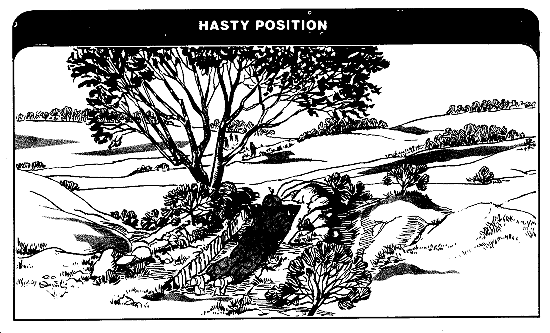
TWO-MAN FIGHTING POSITION
In the defense, you and another soldier will build a two-man fighting
position. Improve your position as time permits.
Keep the hole small. The smaller the hole, the less likely it is that rounds,
grenades, or airburst fragments will get into it. It should be large enough for
you and your buddy in full combat gear. It should extend beyond the edges of the
frontal cover enough to let you and your buddy observe and fire to the front.
The hole is usually dug straight, but it may be curved around the frontal cover.
Curving the hole around the frontal cover may be necessary in close terrain
to allow better observation and fire to the front and to the next flank
position. To curve the hole, simply extend one or both ends of it around the
frontal cover.

A curved hole lets one of you watch for the enemy to the front while the
other sleeps or eats. Also, you can observe and fire to the front when not being
fired at, and move back behind the frontal cover when under heavy fire.
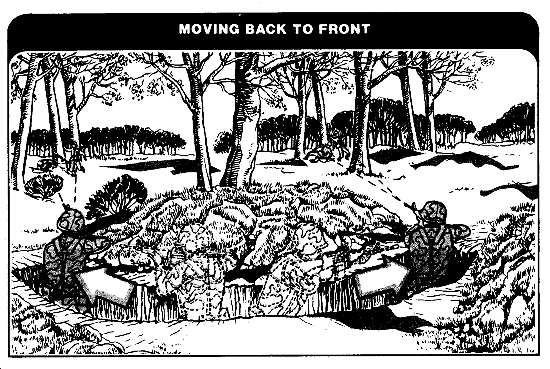
On a steep slope, a straight hole may not let you stay behind frontal cover
and fire at attackers. You may have to stand up and expose yourself to the
attackers' fire.

To avoid such exposure, dig firing ports in each end of the hole. The ground
between the firing ports will then be additional frontal cover.
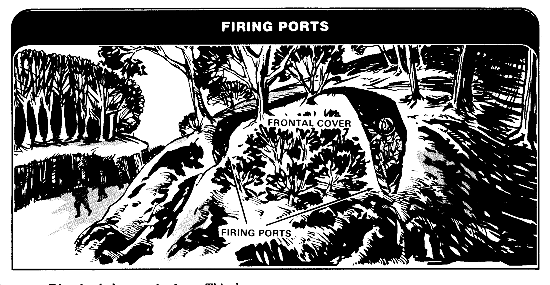
Dig the hole armpit deep. This lowers your profile and still lets you
fire. Other dimensions should be the length of two M16s and the width of two
bayonets.

Leave enough distance between the hole and the frontal cover to make a shelf
where you can put your elbows when firing.
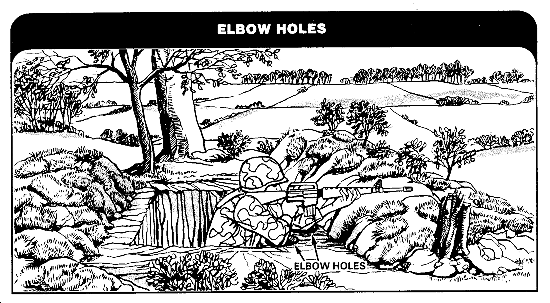
Dig elbow holes to keep your elbows from moving around when you fire.
Your fire will then be more accurate.
If you or your buddy has an automatic rifle, dig a small trench to
stabilize its bipod legs.

Hammer in sector stakes (right and left) to define your sectors of
fire. Sector stakes prevent accidental firing into friendly positions. Tree
limbs about 46 cm (18 in) long make good stakes. The stakes must be sturdy and
must stick out of the ground high enough to keep your rifle from being pointed
out of your sector.
Hammer in aiming stakes to help you fire into dangerous approaches at
night and at other times when visibility is poor. Forked tree limbs about 30 cm
(12 in) long make good stakes. Put one stake near the edge of the hole to rest
the stock of your rifle on. Then put another stake forward of the rear (first)
stake toward each dangerous approach. The forward stakes are used to hold the
rifle barrel. To change the direction of your fire from one approach to another,
move the rifle barrel from one forward stake to another. Leave the stock of the
rifle on the rear stake.
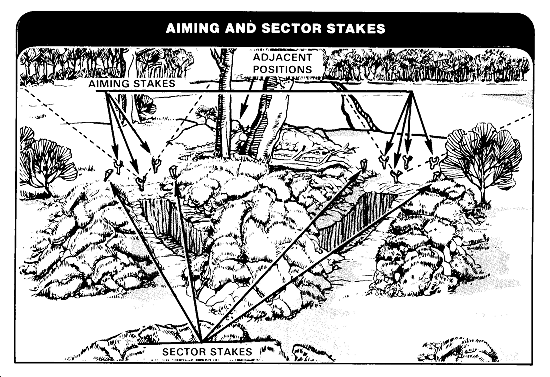
Dig two grenade sumps in the floor (one on each end). If the enemy
throws a grenade into the hole, kick or throw it into one of the sumps. The sump
will absorb most of the blast. The rest of the blast will be directed straight
up and out of the hole. Dig the grenade sumps:
-
As wide as the entrenching tool blade.
-
At least as deep as an entrenching tool.
-
As long as the position floor is wide.
For water drainage, slope the floor of the hole toward the grenade
sumps. This may also . cause grenades to roll into the sumps.
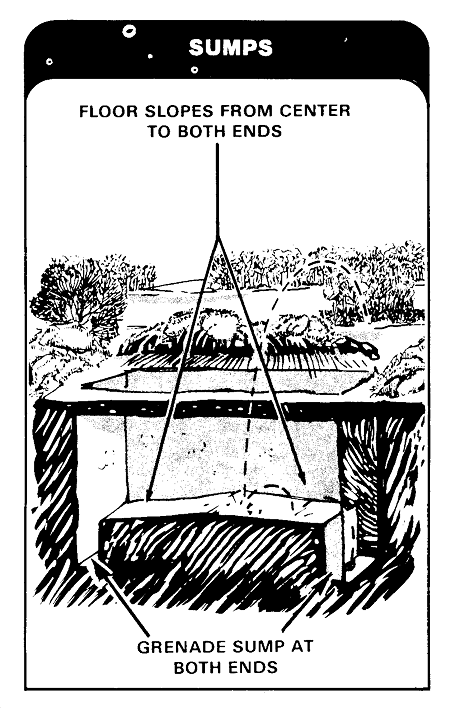
Build overhead cover for protection against airburst fragments. Build
the overhead cover either across the center of the hole or off to its
flanks.


When center overhead cover would not make a position easy to detect, build
it. Put support logs 10 to 15 cm (4 to 6 in) in diameter on top of each other
along the entire length of the frontal and rear cover.
Put logs 10 to 15 cm (4 to 6 in) in diameter side by side across the support
logs as the base for the overhead cover.
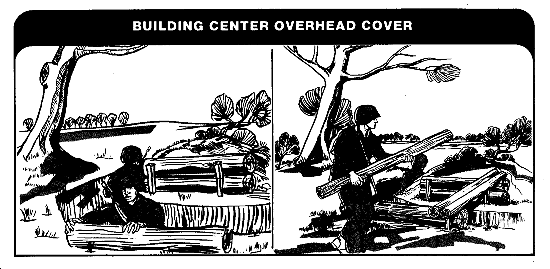
Put a water-repellent layer, such as C-ration boxes or a poncho, over the
base logs. This helps keep water from leaking through the overhead cover.
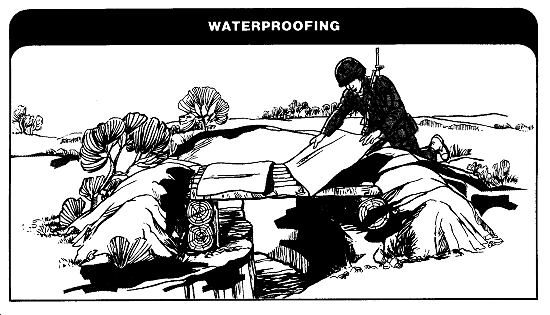
Then put 15 to 20 cm (6 to 8 in) of dirt on top of the waterproofing
material. Finally, mold and camouflage the cover to blend with the terrain.
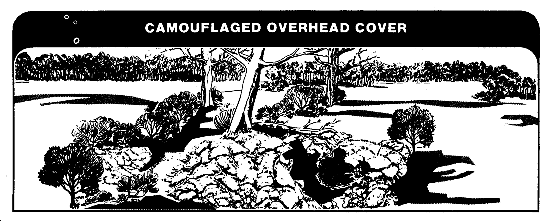
When center overhead cover would make your position easy to detect, build
flank over-head cover. That method gives both you and your buddy your own
overhead cover. However, neither of you can observe or fire into your sectors of
fire while under it.
When flank overhead cover is used, dig only one grenade sump. Dig it in the
center of the floor against the back wall and slope the floor toward it.

Dig out an area for flank overhead cover at each end of the position:
-
About 30 cm (12 in) deep.
-
Long enough to extend about 45 cm (18 in) beyond both sides of the hole.
-
About 1 meter (3 ft) wide.
Save the sod for camouflage.
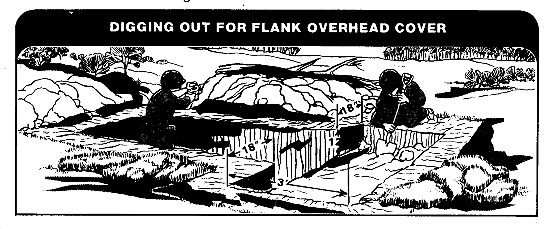
Next, place support logs, about 10 to 15 cm (4 to 6 in) in diameter, across
the dug-out holes. This will support the rest of the overhead cover material.
Put a water-repellent layer, such as C-ration boxes or a poncho, over the
support logs. This helps keep water from leaking through the overhead cover.
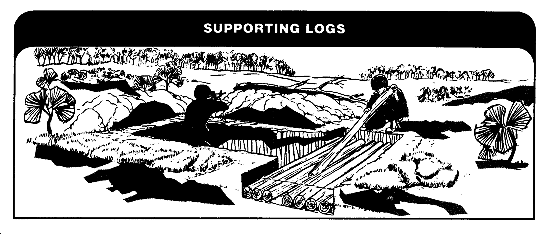
Then put 15 to 20 cm (6 to 8 in) of dirt on top of the waterproofing
material. Cover the dirt with the sod and camouflage it.
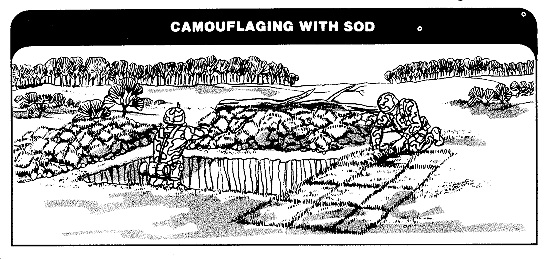
Then get in the hole and dig out a cave-like compartment at each end of the
position under the overhead cover. Dig your compartment large enough for you and
your equipment. Dig your buddy's compartment large enough for him and his
equipment.

In sandy or loose soil, the sides of your position may require
revetments to keep them from collapsing. Use such things as mesh wire,
boards, or logs for revetting. Tie anchor string, rope, or wire to the revetting
material and stake them down. Drive the stakes into the ground. This hides them
and keeps them from being mistaken for aiming stakes or sector stakes.

ONE-MAN FIGHTING POSITION
Sometimes you may have to build and occupy a one-man fighting position.
Except for its size, a one-man position is built the same way as a two-man
fighting position. The hole of a one-man position is only large enough for you
and your equipment.
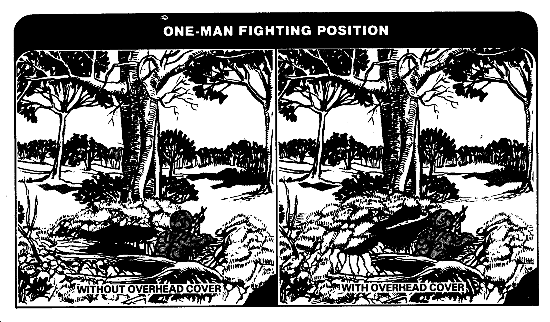
MACHINE GUN FIGHTING POSITION
If you are in a machine gun crew, you and the other members must build a
machine gun fighting position. However, before you can start work on the
position, your leader must:
-
Position the machine gun.
-
Assign it a primary (and a secondary, if required) sector of fire.
-
Assign it a principal direction of fire (PDF) or final protective line
(FPL).
|
NOTE: The FPL is a line on which the gun fires grazing fire across the
unit's front. Grazing fire is fired 1 meter above the ground. When an FPL
is not assigned, a PDF is. A PDF is a direction toward which the gun must
be pointed when not firing at targets in other parts of its sector.
|
The first thing to do when building a machine gun position is to mark the
position of the tripod legs. Then mark the sectors of fire with sector stakes,
and trace the outline of the hole and its frontal cover on the ground.

For an M60 machine gun position, dig two firing platforms for the gun. One
platform is on the primary sector of fire side of the position, and the machine
gun tripod is used on this platform. The other platform is on the secondary
sector of fire side of the position, and the machine gun biped is used when
firing on this platform. A trench must be dug for the bipod legs.

The firing platforms reduce the profile of the gunner. They also reduce the
height of the frontal cover needed. The firing platforms must not, however, be
so low that the gun cannot be traversed across its sector of fire.
In some cases, the floor of the platforms may need to be lined with sandbags.
Also, sandbags may be needed on each tripod leg to keep it from moving.
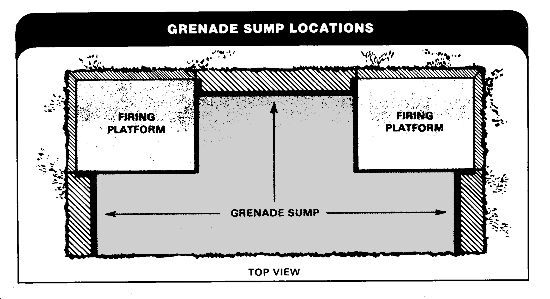
After the firing platforms have been dug, prepare your range card (app I)
and then dig your hole. Dig the hole in the shape of an inverted T. The top of
the T, however, must be longer than the shaft of the T. Dig the hole deep enough
to, protect the crew and still let the gunner fire the machine gun (usually
about armpit deep). Use the dirt from the hole to build frontal, flank, and rear
cover. The frontal cover is built first. When the frontal cover is high and
thick enough, use the rest of the dirt to build flank and rear cover.
Dig three grenade sumps, one at each end of the T. Dig the grenade sumps like
those in a two-man fighting position.
Build the overhead cover for the position like that for a two-man fighting
position.
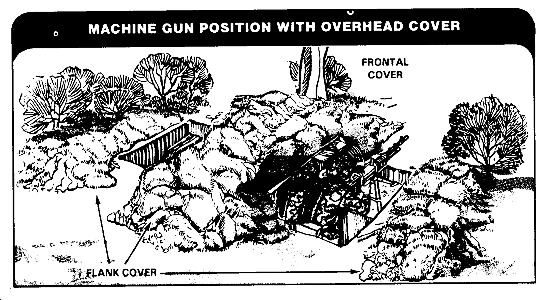
When an M60 machine gun has only one sector of fire, dig only half of the
position (only one firing platform).
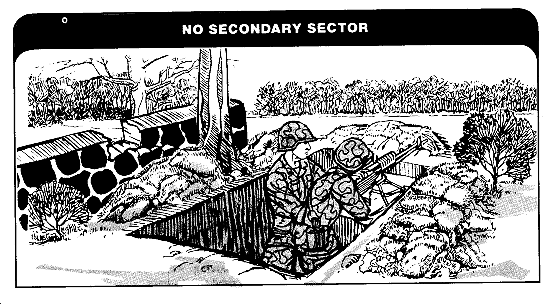
When there is a three-man crew for an M60 machine gun, the third man (the
ammunition bearer) digs a one-man fighting position. Usually, his position is on
the same side of the machine gun as its FPL or PDF. From that position, he can
observe and fire into the machine gun's secondary sector and, at the same time,
see the gunner and assistant gunner. The ammunition bearer's position is
connected to the machine gun position by a crawl trench so that he can bring
ammunition to the gun or replace the gunner or the assistant gunner.
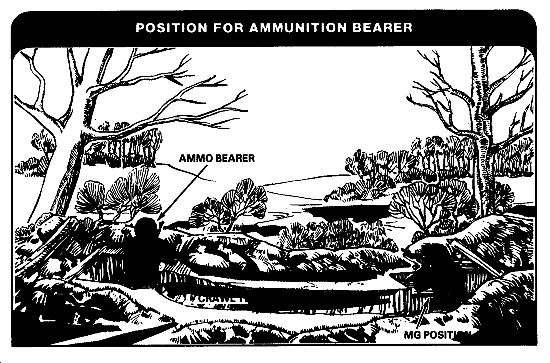
In a caliber .50 machine gun position, dig only one firing platform for the
gun. Dig the platform below ground level, like that for an M60 machine gun
except deeper. Because of the gun's vibrations, you may have to line the floor
of the platform with sandbags. Sandbags may also be needed on each tripod leg to
keep it from moving. Also, the walls of the platform may need revetments.
After digging the platform, prepare your range card and then dig your hole.
The hole should be the shape of an L, with the platform in the center of the L.
Dig the hole deep enough to protect the crew and still let the gunner fire the
machine gun (usually about armpit deep). Use the dirt from the hole to build
frontal, flank, and rear cover. Build the frontal cover first. When that is
completed, use the rest of the dirt to build flank and rear cover.

Dig two grenade sumps, one at both ends of the L, like those in a two-man
fighting position. Build the overhead cover like that for a two-man fighting
position.
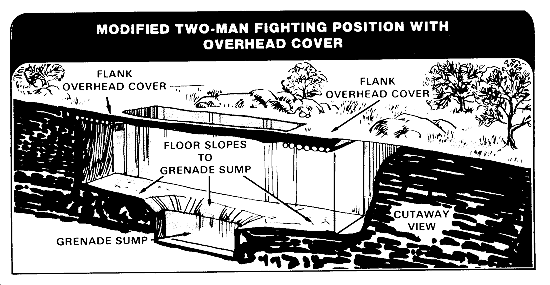
DRAGON FIGHTING POSITION
The Dragon can be fired from either a one-man or a two-man
fighting position. However, you must make some changes in the positions. Like
the machine gun, a Dragon needs a range card. Prepare it before digging your
hole.
Dig the hole wide enough to let the muzzle end of the launcher extend 15 cm
(6 in) beyond the front of the hole and the rear of the launcher extend out over
the rear of the hole. This is to keep the backblast out of the hole.
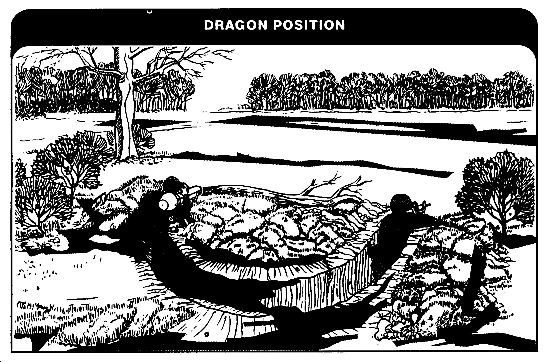
Dig the hole only waist deep on the side the Dragon will be fired
from. This lets you move while tracking. Dig the other side of the hole armpit
deep. Also, dig a small hole for the biped legs in front of the hole. Because of
your height above the ground when firing the Dragon, build frontal cover high
enough to hide you and, if feasible, the backblast.
Build overhead cover on the flanks of the position. Build it large
enough for you, your equipment, and the Dragon. Overhead cover is not usually
built across the center of the hole in a Dragon position. The center overhead
cover would have to be so high that it would be easy for the enemy to spot.

Clear the backblast area before firing the weapon. That means checking to see
if any soldiers are in the backblast area or if any walls, large trees, or other
things are in a position to deflect the backblast. If the weapon is to be fired
from a two-man fighting position, make sure that the other soldier in the hole
is not in the backblast area.
90-MM RECOILLESS RIFLE FIGHTING POSITION
Build a 90-mm recoilless rifle (RCLR) position like a Dragon position, but
dig the hole a little longer when firing to the right side of the frontal cover.
That lets the assistant gunner work from the right side of the RCLR. Prepare
your range card before digging the hole. Also, clear the backblast area before
firing the RCLR.
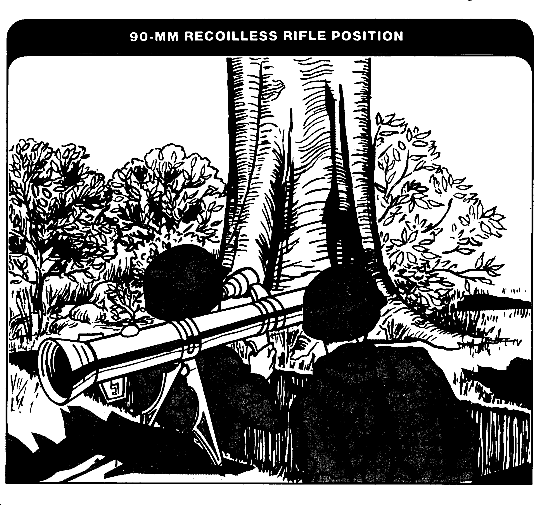
LIGHT ANTITANK WEAPON (M72A2) AND FLAME ASSAULT SHOULDER WEAPON
(FLASH) FIGHTING POSITION
There is no special fighting position for the M72A2 or FLASH. They can be
fired from any fighting position. Before firing any of these weapons, clear the
backblast area.
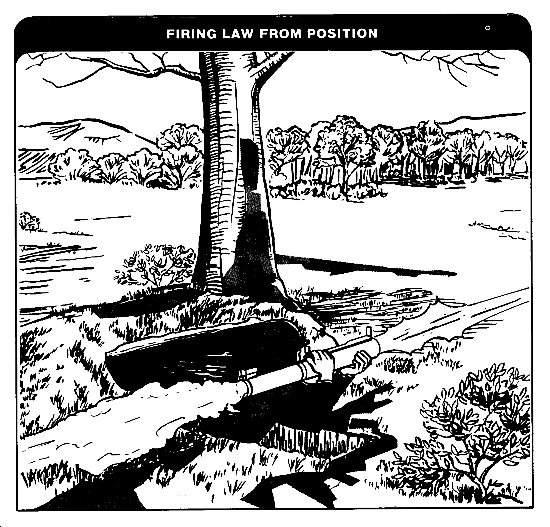
TRENCHES
When there is time, dig trenches to connect fighting positions. Trenches
provide covered routes between positions. The depth of the trenches depends on
the time and type of help and equipment available to dig them. Without engineer
help, crawl trenches about 1 meter (3 feet) deep and two thirds of a meter (2
feet) wide are probably all that can be dug. Dig the trenches zigzagged so that
the enemy will not be able to fire down a long section if he gets into the
trench, and so that shrapnel from shell bursts will lose some of its
effectiveness.
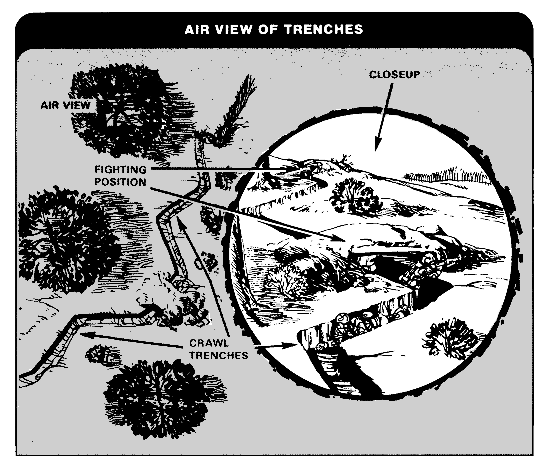
STORAGE COMPARTMENTS
A fighting position should have a place for storing equipment and ammunition.
When your position has overhead cover across its center, dig a storage
compartment in the bottom of the back wall. The size of the compartment depends
on the amount of equipment and ammunition to be stored.
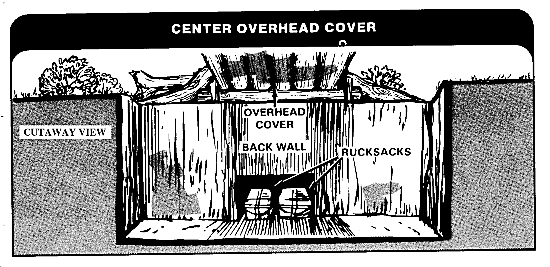
When your position has flanked overhead cover, use the compartments dug for
the overhead cover as storage compartments.

If you dig your storage compartment large enough, it may provide extra space
in which you can stretch out while sleeping. This lets you sleep inside the
position and under cover.
















































